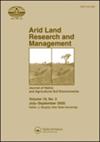Horizontal variability and diurnal fluctuation of soil respiration in corn and soybean rows
IF 1.6
4区 农林科学
Q3 ENVIRONMENTAL SCIENCES
引用次数: 0
Abstract
AbstractThis study evaluated the horizontal variability and diurnal fluctuation of soil respiration to accurately capture changes in carbon flux during agricultural production in Lishu County, Jilin Province, China. Corn (Zea mays L.) and soybean (Glycine max L.) were planted with 60-cm row spacing in 2020. The soil respiration rate (SRR) was measured at 2-hour intervals on July 1, August 1, and September 25 using a portable, closed chamber at five positions, P0, P15, P30, P45, and P60, denoting specific distances from the crop rows. The SRR between crop rows was affected both by dates and fields with the coefficient of variation ranging between 7.1 and 37.7%. The SRR at P45 was closest to the mean SRR, with a relative deviation of 0.09–4.85% on July 01 and August 01 in corn and soybean fields. On September 25, the optimal position to measure SRR was between P45 and P60. The sampling dates influenced the optimal time for measuring SRR but were mostly concentrated between 9:00 and 11:00 (24-hour clock) for corn and between 11:00 and 13:00 for soybean. The root biomass of crop rows and diurnal soil temperature were the main factors affecting horizontal variability and diurnal fluctuation of SRR, respectively. We recommend an SRR sampling strategy at P45 between 9:00 and 11:00 for corn and between 11:00 and 13:00 for soybean to decrease the effects of horizontal variability and diurnal fluctuation of SRR.Keywords: Corn and soybean rowsdiurnal fluctuationhorizontal variabilitysoil respiration Disclosure statementNo potential conflict of interest was reported by the author(s).Additional informationFundingThis work was financially supported by the National Key Research and Development Program of China [no. 2021YFD1500802]; the NSFC-Jilin Joint Fund Project, China [no. U19A2035]; and the 2115 Talent Development Program of China Agricultural University [no. 1191-00109011].玉米和大豆行土壤呼吸的水平变异和日波动
摘要为准确捕捉农业生产过程中土壤呼吸的水平变异和日波动,研究了吉林省梨树县土壤呼吸的水平变异和日波动。2020年以60 cm行距种植玉米(Zea mays L.)和大豆(Glycine max L.)。土壤呼吸速率(SRR)于7月1日、8月1日和9月25日每隔2 h在pp0、P15、P30、P45和P60 5个位置(代表与作物行距的特定距离)采用便携式密闭室测量。行间SRR受日期和大田的影响,变异系数在7.1 ~ 37.7%之间。玉米和大豆在7月1日和8月1日在P45处的SRR与平均SRR最接近,相对偏差为0.09 ~ 4.85%。9月25日测量SRR的最佳位置在P45 ~ P60之间。玉米和大豆的最佳测定时间主要集中在9:00 ~ 11:00(24小时制)和11:00 ~ 13:00之间。作物行根生物量和土壤日温度分别是影响SRR水平变异和日波动的主要因子。建议玉米和大豆的SRR取样时间分别为P45点(9:00 - 11:00)和11:00 - 13:00(13:00),以减小SRR水平变异性和日波动的影响。关键词:玉米和大豆种植日波动水平变异土壤呼吸披露声明作者未报告潜在的利益冲突。本研究由国家重点研究与发展计划资助[no. 1];2021年yfd1500802];国家自然科学基金-吉林省联合基金项目[no. 1];U19A2035];中国农业大学“2115”人才发展计划项目[j];1191 - 00109011]。
本文章由计算机程序翻译,如有差异,请以英文原文为准。
求助全文
约1分钟内获得全文
求助全文
来源期刊

Arid Land Research and Management
环境科学-环境科学
CiteScore
3.80
自引率
7.10%
发文量
23
审稿时长
9 months
期刊介绍:
Arid Land Research and Management, a cooperating journal of the International Union of Soil Sciences , is a common outlet and a valuable source of information for fundamental and applied research on soils affected by aridity. This journal covers land ecology, including flora and fauna, as well as soil chemistry, biology, physics, and other edaphic aspects. The journal emphasizes recovery of degraded lands and practical, appropriate uses of soils. Reports of biotechnological applications to land use and recovery are included. Full papers and short notes, as well as review articles and book and meeting reviews are published.
 求助内容:
求助内容: 应助结果提醒方式:
应助结果提醒方式:


